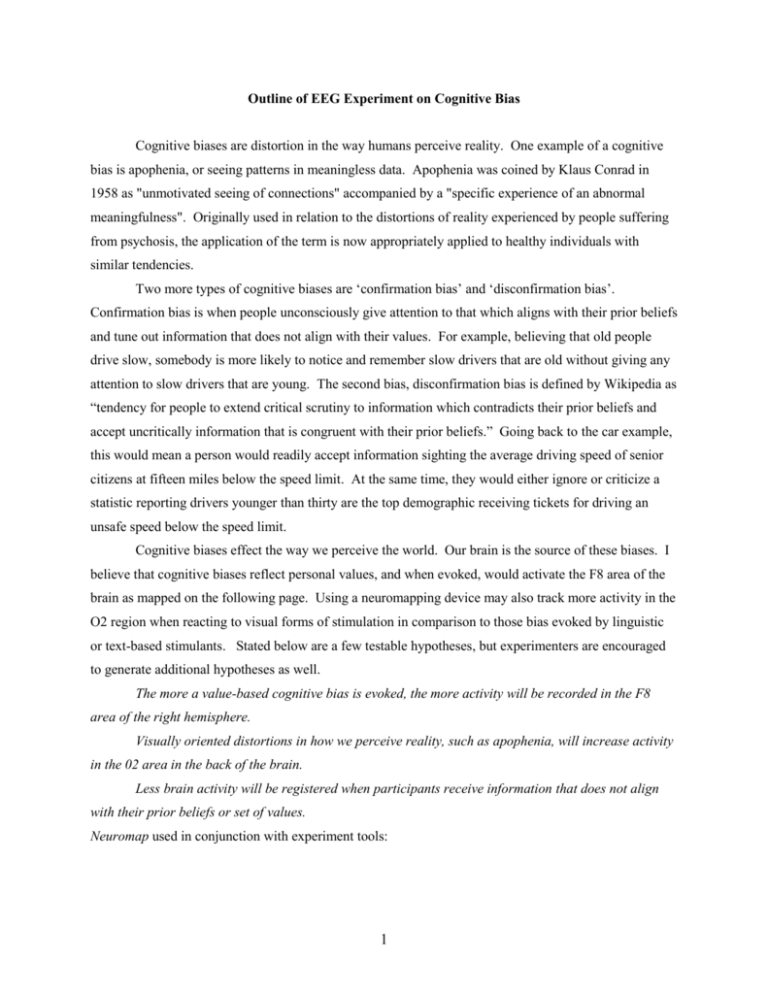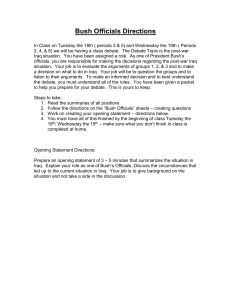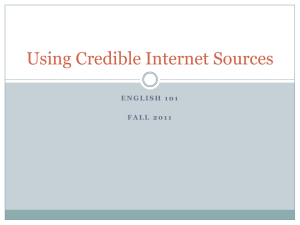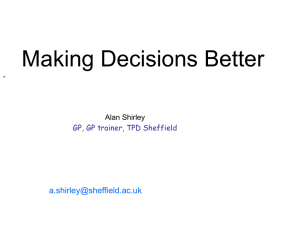Outline of EEG Experiment on Cognitive Bias
advertisement

Outline of EEG Experiment on Cognitive Bias Cognitive biases are distortion in the way humans perceive reality. One example of a cognitive bias is apophenia, or seeing patterns in meaningless data. Apophenia was coined by Klaus Conrad in 1958 as "unmotivated seeing of connections" accompanied by a "specific experience of an abnormal meaningfulness". Originally used in relation to the distortions of reality experienced by people suffering from psychosis, the application of the term is now appropriately applied to healthy individuals with similar tendencies. Two more types of cognitive biases are ‘confirmation bias’ and ‘disconfirmation bias’. Confirmation bias is when people unconsciously give attention to that which aligns with their prior beliefs and tune out information that does not align with their values. For example, believing that old people drive slow, somebody is more likely to notice and remember slow drivers that are old without giving any attention to slow drivers that are young. The second bias, disconfirmation bias is defined by Wikipedia as “tendency for people to extend critical scrutiny to information which contradicts their prior beliefs and accept uncritically information that is congruent with their prior beliefs.” Going back to the car example, this would mean a person would readily accept information sighting the average driving speed of senior citizens at fifteen miles below the speed limit. At the same time, they would either ignore or criticize a statistic reporting drivers younger than thirty are the top demographic receiving tickets for driving an unsafe speed below the speed limit. Cognitive biases effect the way we perceive the world. Our brain is the source of these biases. I believe that cognitive biases reflect personal values, and when evoked, would activate the F8 area of the brain as mapped on the following page. Using a neuromapping device may also track more activity in the O2 region when reacting to visual forms of stimulation in comparison to those bias evoked by linguistic or text-based stimulants. Stated below are a few testable hypotheses, but experimenters are encouraged to generate additional hypotheses as well. The more a value-based cognitive bias is evoked, the more activity will be recorded in the F8 area of the right hemisphere. Visually oriented distortions in how we perceive reality, such as apophenia, will increase activity in the 02 area in the back of the brain. Less brain activity will be registered when participants receive information that does not align with their prior beliefs or set of values. Neuromap used in conjunction with experiment tools: 1 2 Testing This experiment requires the use of a device capable of measuring brain activity in accordance the neuromap shown above. A minimum of two facilitators, as well as 15-20 subjects would ideal for this project. For each participant, one facilitator should measure the circumference of the subject’s cranium and situate the appropriate sized cap. Once the foam pads and cap are properly positioned, the facilitator should use the syringe to insert plenty of conducting gel at each node, even wiggling the tip of the syringe around to ensure the area is covered. To test the conductivity, one facilitator should tap each node individually while the other reports the amount of feedback shown on the computer screen. Once it is confirmed that the equipment is properly set up, check to make sure the cap is strapped down to reduce any physical movement from compounding the feedback from the brain. Next, administer a series of activities to test the different hypothesis proposed. Here is an example of a questionnaire designed to test confirmation and disconfirmation biases in political news. Two excerpts of news stories will be provided from partisan news sources. One source will be FoxNews.com, widely believed to be a conservative news source, and the other from CNN.com a more liberal news provider. From each source, a story will be pulled that appears negative toward Bush’s war policy in Iraq and one that is positive. Using the different sources should control for reporting biases. The sources of these stories will not be revealed to the participants who will be asked a few questions using the Likert scale after reading each story. Based on the wording of the stories, the content, and the party affiliation of the participants, it will be interesting to see if cognitive biases are traceable in the brain activity reported. Political News What is your party affiliation? Instructions: Please read the following news excerpts and answer the questions below. “Ramadi, Iraq — “We’re here to win.” That’s how a U.S. Marine corporal put it, when I asked what he was doing in Iraq. He spoke, looking squarely into our TV camera — a more intimidating experience for him than the RPG fire he had just faced on the streets of this beleaguered city. When I pressed this 20-year-old from the heartland of America to tell me what “winning” meant to him, he was straightforward: “That’s when these people don’t need me to guard this street so their kids can go to school — when they can do it themselves.” 3 The young corporal and I were standing outside a small elementary school in this shattered city — capital of the largest province in Iraq. Al Qaeda terrorists had told local authorities — on pain of death — not to allow this female academic institution to un-shutter its doors. Apparently, little girls learning math and science pose a significant threat to radical Islamic jihadists.” -How credible do you find this source? Not Credible 1 2 3 Neutral 4 5 Very Credible -Do you feel this story reflects positively on the political party you affiliate with? -Without looking back at the text, please write down to the best of your memory the point of this news story was? -Would you categorize your response to this article as positive or negative? WASHINGTON (Reuters) -- President Bush will soon seek about $100 billion in additional emergency funds for the wars in Iraq and Afghanistan, according to a House report Wednesday. Filed by Democratic staffers for two key panels in the House, the report's revelations mark a rapid escalation in the cost of the Iraq war at a time when public support is plummeting. In a broad report criticizing Republicans' fiscal decisions, Democratic staffers on the House Appropriations Committee and House Budget Committee also noted that Congress has already appropriated about $379 billion for the war in Iraq. "The administration is expected to submit an additional request early next year that will total roughly $100 billion. At least three-quarters of this request will support operations in Iraq," according to the report. If the White House asks for the $100 billion, it would be significantly less than the $130 billion the Pentagon requested recently, according to several accounts. 4 The emergency funds, which likely would be submitted by Bush to Congress in early February, would be in addition to $70 billion already approved for the two wars in the current fiscal year, which began October 1. -How credible do you find this source? Not Credible 1 2 3 Neutral 4 5 Very Credible -Do you feel this story reflects positively on the political party you affiliate with? -Without looking back at the text, please write down to the best of your memory the point of this news story was? -Would you categorize your response to this article as positive or negative? BAGHDAD — The United Nations said Wednesday that 3,709 Iraqi civilians were killed in October, the highest monthly toll since the March 2003 U.S. invasion and another sign of the severity of Iraq's sectarian bloodbath. The U.N. tally was more than three times higher than the total The Associated Press had tabulated for the month, and far more than the 2,866 U.S. service members who have died during all of the war. The report on civilian casualties, handed out at a U.N. news conference in Baghdad, said the influence of militias was growing, and torture continued to be rampant, despite the government's vow to address human rights abuses. -How credible do you find this source? Not Credible 1 2 3 Neutral 4 5 Very Credible -Do you feel this story reflects positively on the political party you affiliate with? 5 -Without looking back at the text, please write down to the best of your memory the point of this news story was? -Would you categorize your response to this article as positive or negative? WACO, Texas (CNN) -- President Bush Sunday said the trial that led to the conviction and death sentence of Saddam Hussein is "a major achievement for Iraq's young democracy." Hussein was ousted from power following the U.S.-led military invasion in 2003. A five-judge panel sentenced him to death by hanging Sunday after he was convicted for the brutal 1982 crackdown on the Shiite town of Dujail. Two other defendants were also given the death sentence. "Saddam Hussein's trial is a milestone in the Iraqi people's efforts to replace the rule of a tyrant with the rule of law," said Bush, speaking on the tarmac of Waco's airport before heading to Nebraska for a campaign event. Bush noted that through the appeals process, Hussein "will continue to receive the due process and legal rights that he denied to the Iraqi people." Democrats and Republicans uniformly praised Sunday's verdict. -How credible do you find this source? Not Credible 1 2 3 Neutral 4 5 Very Credible -Do you feel this story reflects positively on the political party you affiliate with? -Without looking back at the text, please write down to the best of your memory the point of this news story was? 6 -Would you categorize your response to this article as positive or negative? In addition to this questionnaire, participants should be given a sheet with an inkblot or other meaningless data to test for visually stimulated distortions of reality. This is the standard method of testing for apophenia. Instructions: What do you see? Carefully monitor brain activity throughout each exercise, recording and measuring the changes to the best of your ability. Reflect on the findings, patterns, and abnormalities you observed. Draw conclusions in regards to your original hypothesis. Conclusion This experiment design is merely one sample study that could be executed with the brain mapping equipment. Other experiments designed to test your brain’s reaction to sensory stimulus, memory challenges, decision making, or math problems would yield very different sets of brain activity data. I really enjoyed familiarizing myself with this device and exploring the wide range of the technology’s possible applications. If this equipment was used more frequently in our society to explain and test human behavior, a possible implication could be that ‘free will’ might be challenged. I believe the data produced by this equipment could make a surprising argument for strong biological factors that drive our behavior. Overall, I found this independent research project very stimulating and I now have a heightened interest in this area of study. The hands-on opportunities that Professor Nardi made available deepened my understanding of the process and results of this study. More social science classes should adopt this approach to testing theories and running experiments. 7






